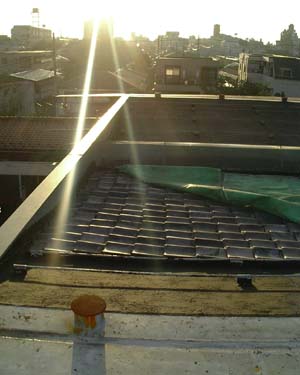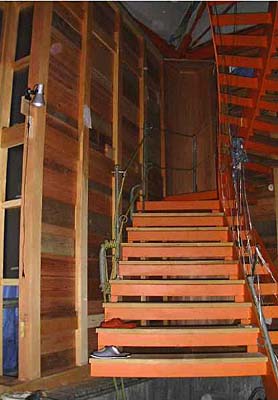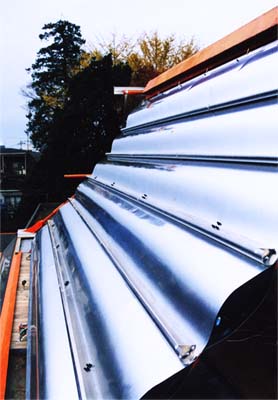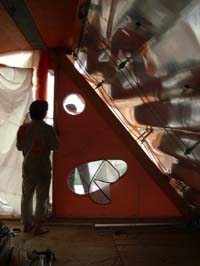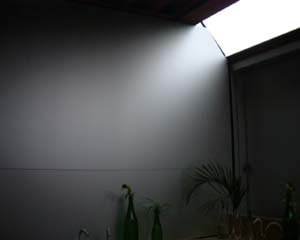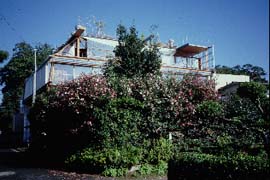
Project File : SETAGAYA-MURA[Open Tech House #1]
GA Houses 68
ĄThe road to Having Your Own Way
Kobun ITO
from AXIS vol.87
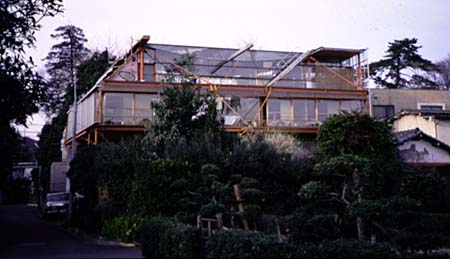
Recently, however, there are only a few of these "have it my way" houses. One reason for this is the highly diminished authority of the owner/builder. Even if the husband is the builder, he is still only the representative of the house. There is also less free time for the owner/builder to do the work by himself, and the degree to which you can have it your own way has gotten smaller.
In any case, no matter what the reasons are, the decrease in these types of homes is not a good thing. It implifies the weakening of the individual' s ability to fight things through, and the lack of imagination. The framework of the manufacturers and distributors of houses take precedence and the occupant must satisfy his desires within their given outline. If left alone, the framework will become more entrenched and constrained. While I' d like to put a stop to this situation, there is a mood of resignation that further strengthens that framework. What we need now is unbridled " selfishness" and "recklessness." That's the only thing that will poke through the framework and stop this vicious cycle.
Mr. Osamu Ishiyama, architect, is building his home in Setagaya, Tokyo. It's an odd spectacle in a remarkably average residential area. It's a traditional Japanese style wooden one-story house built 40 years ago. Some of the rooms have been taken away, exposing the interior wall, and a section of the roof has been removed, too. The building looks somewhat dilapidated. A large steel frame structure stands over it as if trying to cover it. There are no columns to be found. Actually, there are columns, but at 20cm in diameter they can hardly be conceived as the four pillars that must support a three-story structure. The braces that randomly dance in the air, and the tension materials such as suspension beams that support the second and third floors, are not much different in dimensions compared to the various secondary steel materials. The whole thing seems like a spider's web of steel. Although the site doesn't have much a margin for development, the builder is used to traditional wooden house and wants to minimize the economic costs and the stress of changing residences.
The house is half self-built. The work on the steel frame was left to a professional, but the young people at Mr. Ishiyama's office did most of the remaining tasks. He bought the materials whenever he came up with the money to pay for them, and is doing the finishing work with his own hands within the scope of his technique. That means it is semi-permanently uncompleted. It is quite poignant that he had dispensed with the notion of "completion" from the very start.
Mr. Ishiyama is an architect who advocates an open system when it comes to building technologies and techniques. This approach involves tearing down the walls that hem in the narrow field of architecture, and surveying with equal weight the technologies of other fields. From these one select what has the capacity to do the job with consideration given to cost performance. It does not depend on other organizations or go-betweens; one adopts what's needed with one's own hands and puts it together - if you can't find what you need in existing technology, you make it yourself. This house was planned as a place to apply that open system technology.
Even now you can see a number of experiments going on. The homemade aluminum curtain wall on the west wall fassade, for example. They took two sheets of existing rolled aluminum and pressed them together at equal intervals, and placed air duct in between to give it some depth. He had the wild idea of building a horizontal gutter along the narrow part of the structure so that moss can grow and act as insulation. There is also the irregular wall face made from converted wet suit material and the aluminum honeycomb floorboards made from aluminum cans. And these are just the tip of the iceberg. The self-sustaining energy system--a combination of wind power, sunlight, and oil (for a water-cooled diesel engine for generating the household`s electricity) - and the roof vegetable garden are yet to be completed.
By the way, this house is called "Setagaya Mura (village)". It will be home to Mr. and Mrs. Ishiyama, their eldest son and second daughter, Mr. Ishiyama's mother, uncle, and an exchange student. Mr. Ishiyama plans to build an office and gallery on the first floor. It is called the " Setagaya Mura" instead of a "residence" because it is a mix of workplace and home. At present, the second and third floors - living spaces linked via an open ceiling atrium - are sectioned by plastic tents to secure living spaces. He says he will merely replace the tents with wooden screens in the future but he won't build any permanent walls.
Here the stable composition of family and kin is dismantled and each person is treated as an independent individual. A person living a stable life in a stable environment might feel this is too hectic and inconvenient. But if you see "Setagaya Mura" not as a private home but as a society, the inconveniences are not worth taking into consideration. The individual, within the scope of his abilities, secures a place of his own in which to live. And Setagaya Mura is just laying bare this clear logic a little more than other projects.
In this way, when Mr. Ishiyama's lone excursion, born of the "having it my way" attitude, collides with the same attitude on the part of other interested parties, things speed up and run out of control. But still it does somehow manage to create a form, if just barely. This is the present state of "Setagaya Mura." We'd like to hope that these excursions continue, because an architect designing his own home might be able to open up new fields in architecture. (Coordination by Noriko Kawakami)
